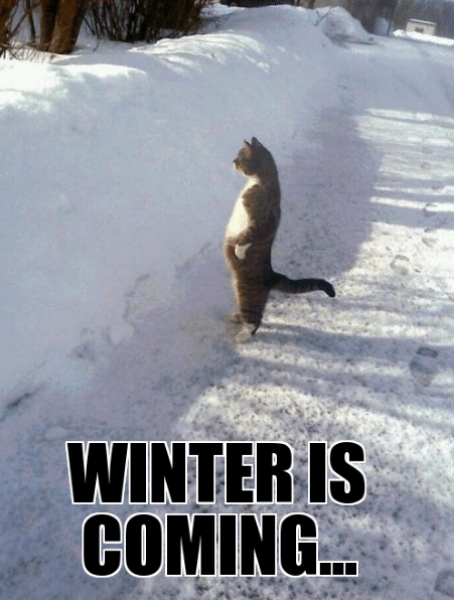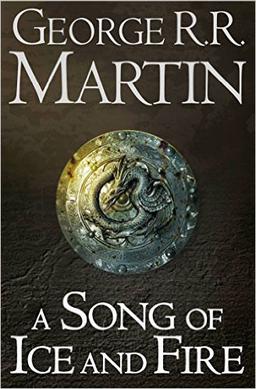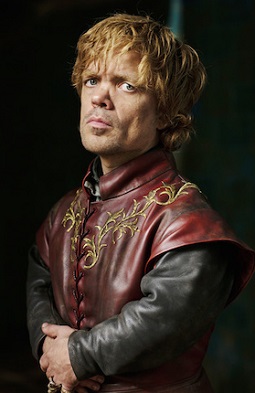Foreword

This was originally written a decade ago; back then the fifth book of the series hadn’t come out yet, and Game of Thrones, the HBO television series, had only just started with a few episodes of season one. A decade later and we’ve gotten one more book, A Dance with Dragons (coming out shortly after this review appeared), and the HBO series completed after eight seasons, with another prequel television series in the works — not to mention the countless board, card and video games, a ton of junk memorabilia and endless memes.
In short, a cultural phenomena.
OK, that’s a bit of a stretch, but you get the idea. And I should note, while it has taken 10 years and counting for the next book in the Ice and Fire series, The Winds of Winter, to come out, author George R. R. Martin has in the interim published Fire and Blood in 2017. This is the first of two books on which the new television series prequel is based. I haven’t read it myself, but I still stand behind what I have to say with regard to the rest of the Ice and Fire series.
Part 1: Grit, Gore, Grime and Gams Make for Busy Knights
Originally posted on May 5, 2011
What better way to inaugurate Barking Book Reviews (an erstwhile site of mine) than a review of George R. R. Martin’s Song of Ice and Fire series? It’s immensely popular within the fantasy/sword-and-sorcery genre among both readers and critics; the various books in the series have all been nominated for Locus, Hugo, Nebula and World Fantasy awards; the first in the series, A Game of Thrones, won a Locus award. The fourth book, A Feast for Crows, debuted at no. 1 on the New York Times bestseller list upon its initial publishing in 2005 – the first fantasy genre book to do so. As if that weren’t enough, the fifth book in the series, A Dance with Dragons, is already listed among the top 10 fantasy ebooks on Amazon.com; it was sitting at no. 10 as of this posting. The thing of it is, that’s just for preorders; it won’t be published until later this year in July.

Then there is the television series based on the first novel in Ice and Fire, Game of Thrones, that just debuted on HBO a few weeks ago. This is bringing Martin new fans judging by the appearance of the books in various book sales lists. As for myself, I just finished the fourth and most recent book in the series, A Feast for Crows, and am looking forward to the erstwhile fifth book in the series, some six years in the making.
A confession: I’m a little skeptical of the gritty/realism movement in fantasy; if you can’t write well in the first place, trying to be gritty or modern isn’t going to help. Yet it seems many authors use this as a crutch, and manage to get published. But if I may indulge in a bit of grit myself: all the mayo in the world can’t turn chicken shit into chicken salad; would that it could. Plus … realistic fantasy – bit of an oxymoron, that.
Furthermore, while I do not read a lot of fantasy and sword and sorcery, the authors I do read, I tend to read closely. In fact, I’m enough of a Tolkien nerd that I read scholarly critiques and annotated versions of his works. But generally speaking, Martin does gritty better than others. At times over the course of the books (so far) he does get carried away with the grit – not so much in the first book, Game of Thrones, nor in the fourth one, Feast for Crows, both of which are fairly taught narratives.
This is particularly true when they are compared to the middle works, A Clash of Kings and A Storm of Swords; in these two there is plenty of gratuitous sex and violence. Now I like sex and violence when it serves to move the plot or characterization along. And there’s nothing wrong with gratuitous sex even when it doesn’t do those things – if it’s well written and titillating. But sex in Martin’s works isn’t particularly titillating – he probably shouldn’t forsake fantasy and science fiction for erotica – so some of the gratuitous sex is a bit annoying and distracting, at times. More on this later.
A Song of Ice and Fire: the Short of It
Warning, a HUGE WALL OF TEXT ensues — in two parts, no less; an epic in which each part spans hundreds of pages perhaps deserves a critique of several thousand words. Plus there is a huge wall on the northern border of Westeros, so this is perhaps apropos.
Want to skip it? Let it suffice to say that perhaps Martin doesn’t always do gritty realism as well as it could be done (yet at times he does indeed), but it is a cut – a detailed, bloody one from groin to collarbone that causes bowels and other assorted entrails to fall out – above the standard bookshelf fare when it comes to quote-unquote realistic fantasy. And if you like fantasy and sword-and-sorcery epics, and you’re okay with the aforementioned grittiness and gray ethical areas, Martin’s Song of Ice and Fire series is definitely worth a read.
It’s not without its faults, some of them considerable and some potentially deal breakers for some readers. But on the whole this epic is an enjoyable diversion, reasonably well written (usually) and at times even thoughtful. On the other hand, if you want your fantasy more traditional – beautiful and immortal elves, elderly but powerful wizards, magic spells and charms, shining white knights skilled at swordplay and damsel rescue, orcs, goblins, dark lords specializing in ultimate evil and world domination, etc. – with clear boundaries between good and bad – A Song of Ice and Fire is not for you.
And that’s not to imply that modern fantasy with those elements can’t be good (just look at Tolkien, the author who started us down this road). Rather, you simply won’t find it in these books of Martin’s.
The Long of It: The Strengths of A Song of Ice and Fire
One of the things that recommends Martin’s series and makes its considerable length justified is its characterizations. One of the things that proponents of gritty, realistic fantasy often cite about this genre – I suppose its probably considered a full-fledged sub genre, at this point — is that, like real life, seemingly nothing is black and white; there is no ultimate good and no ultimate evil. You will find no Aragorn, Gandalf or Frodo in Westeros, the small continent (or perhaps a portion of a larger one) in which the majority of Ice and Fire is set.
For that matter, you won’t find Sauron, Nazgûl, orcs, goblins – nary a hobgoblin, even. There are giants riding mammoths, dragons and the seemingly implacably evil “Others” but they are largely in the background of these first four works – although Martin uses the Others, an ancient evil that hasn’t been seen in Westeros in thousands of years, to bring about several pivotal scenes/plot complications in the third book, A Storm of Swords – not to mention the prologue of the first book.
Yes, magic is there in Westeros and the mysterious, exotic lands to the east across the Narrow Sea, but it is typically in the background. In the foreground we have several dynastic families at the pinnacle of a feudal system reminiscent of medieval Europe – lords, ladies, servants, knights, lusty wenches and washer women, learned men in robes – there’s even an analog to the early Catholic Church, as well as the Old Gods, which are clearly analogous to Druidic beliefs (although unlike their real-world counterparts, these two belief systems don’t seem to be troubled with one another).
In fact, while Martin’s Song of Ice and Fire has been praised for being original in terms of fantasy, one could argue that in many ways it gives us a trite and stereotypical view of medieval Europe – but then, this isn’t a history lesson but popular fiction. All of these families are warring for control of their various lands and ultimately, all of Westeros. Indeed, as many others have remarked, it reminds one who is familiar with British history of nothing so much as the War of the Roses and its aftermath; Henry the VIII would have been quite at home in Westeros – and probably would have fared much better than Martin’s King Robert, a fellow epicure. Certainly Henry would be quite at home with the heads that constantly roll from torsos in Ice and Fire.

Again, there are no elves to be found, and the dwarves are, well, really dwarves, as in people who fit the clinical, medical definition of a dwarf, as opposed to those of German and Scandinavian mythology and Tolkien, et al. And unlike Tolkien’s dwarves, Martin’s Tyrion, a dwarf central to the ongoing plot of the entire series, can be valiant in battle, but only because he’s left little choice; it’s certainly not his idea of a pleasant way to pass an afternoon. As Tyrion himself says shortly after his first battle near the end of Game of Thrones: “No, I’m done with fields of battle, thank you. I sit a chair better than a horse, and I’d sooner hold a wine goblet than a battle-ax. All that about thunder of the drums, sunlight flashing on armor, and magnificent destriers snorting and prancing? Well, the drums gave me headaches, the sunlight flashing on my armor cooked me up like a harvest day goose, and those magnificent destriers shit everywhere.” Gimli son of Gloin he most certainly is not (although they largely seem to share the same opinions on horses).
Tyrion: Everyone’s Favorite Dwarf
Tyrion is one of the best examples of the in-depth characterization we find in Martin’s Ice and Fire. Again, while in some respects the series’ length is a weakness, its length does lend itself to some in-depth character development. As for Tyrion, being a dwarf in a feudal society – even being the scion of House Lannister, one of the most powerful families in Westeros – is surely no easy thing. He is a major character of the first three novels, and presumably will return in the fifth. When we first meet Tyrion he is seemingly drunk, debauched, cynical and more than a tad pompous, not to mention ugly, Martin tells us – he’s known even among his immediate family as The Imp – but we quickly learn in the span of a few chapters that there is more to Tyrion Lannister than his stature and cynicism might suggest.
He realizes that as he has no means to be a champion of arms, like his brother Jamie – reputedly one of the best swordsmen in the realm – his mind must be his weapon; it is his wits that he wields instead of a sword. Over the course of the first three books we get to watch Tyrion wield his wits quite effectively as he navigates the politics inherent to the game of thrones, not to mention that of war and family; Martin also draws out Tyrion’s painful history in bits and pieces, as the debauched dwarf of the initial chapters becomes one of the most interesting and complex characters of the entire series.
Indeed, many of the principal characters of the book remain one dimensional – granted, those characters tend not to last long, however, so I won’t name names – spoilers are the bane of a potboiler review, and at its core Ice and Fire is nothing if not a political potboiler. You’ll just have to take me at my word. But Tyrion becomes a fully fleshed character, and I confessed I missed his absence in the fourth book. Fortunately, as relayed on on fan site Westeros.org, it seems Tyrion will be one of the character narrators when the fifth book Dance With Dragons is published.
Jaime: One of Many Lannisters We Love to Hate

Serving as somewhat of a foil to Tyrion is his brother Jamie; he is everything Tyrion is not: literally a knight in shining armor that exhibits unparalleled prowess with sword and shield, and the object of many a maiden’s fantasy. He is the golden boy of House Lannister and the pride and seeming protege of its partriarch, Tywin Lannister (one of the aforementioned one-dimensional characters, he is almost a stock bad guy: intelligent, rich, cultured, manipulative, cold and evil; if Henry the VIII would feel at home in Westeros, Tywin Lannister would feel right at home in Tudor-era England, and probably in the offices of a modern-day global business conglomerate).
In fact, we quickly see that Jamie is despicable, and even evil. Again, details would only give away major parts of the entire story arc. Let it suffice to say that Martin establishes Jamie’s initial character quite early on in the first book. And yet, over the course of the next three books, things happen to Jamie that change him – it’s not a dramatic change (although the events that drive these changes are) but a gradual one that Martin couples with glimpses into the recent past as well as the childhood that he shared with Tyrion and their sister, Cersei (the queen of Westeros at the time Game of Thrones begins, and really the spiritual heir of Tywin Lannister, as opposed to Jaime).
In fact, by the end of A Feast for Crows, Jamie, if not a sympathetic character, is at least not the one-dimensional, sick and despicable golden boy of A Game of Thrones; he becomes one of the more interesting and complex characters in the series. Furthermore – and this is a credit to Martin as a writer, in as much as his characterizations go – by the end of the fourth book it’s actually kind of hard not to like Jamie, at least a little bit, in spite of the awful things he does early on. We learn that he is not quite so single-minded or as self-centered as he seems and even displays a dry, self-deprecating humor in the face of diversity and life-threatening situations – again, I can’t say more without spoiling a major plot complication or two.
It is this humor, more than anything else, perhaps coupled with a sensitivity that one wouldn’t have thought he possessed – he’s almost downright philosophical by the end of book four – that makes Jamie likable, and even sympathetic. With the house of power that Tywin Lannister built beginning to crumble – okay, bit of a spoiler, that, sorry – by the end of the fourth book, I found myself hoping that Jamie would escape the apparent worst of it to come in the books ahead – despite the fact that he undeniably deserves it.
There are other fully-realized characters as well. There is Arya, for example, the tomboy daughter of House Stark that serves as foil to her older sister, Sansa. Sansa ascribes to be a lady and dreams of being queen; she entertains fantasies of being courted by chivalrous knights and the magic of the royal court (at least she does in the beginning; later on she becomes … less than enamored, shall we say, with these ideas). Arya, by contrast, dreams of being a knight herself with sword in hand, dispatching her enemies with martial aplomb. Then there is Brienne of Tarth; she could easily have been a stock hottie warrior maiden character and its to Martin’s credit that she is not.
One … No Two Three Other Things
Speaking of Brienne, I won’t presume to offer a feminist critique of A Song of Ice and Fire here, although that would certainly be interesting examination and discussion. Furthermore, I don’t think that anyone is going to mistake Martin’s writing for that of Joanna Russ or James Tiptree. But I would claim that there are more fully-realized female characters in this tome than one would perhaps expect, especially given all of the wenching, raping, pillaging – that gritty realism – and so forth.
And in addition to its in-depth characterization, the series’ length lends itself to its political potboiler plot and subplots. Martin’s Song of Ice and Fire is arguably also an historical epic, albeit a fictional one. Needless to say it would be hard to squeeze into one standard novel-sized work all of these fully realized characters — and myriad one-dimensional ones — along with the sweeping milieu of warfare and politics that spans generations and sweeps back and forth across a continent – not to mention all the beheadings, bebowelings, hangings and raunchy medieval sex and rape.
Thus let it suffice to say in this day and age when many readers seem to equate literary quality with quantity (sadly enough), Martin undeniably delivers on this score (each book in the series gives even the wordiest Leon Urises of the literary world a run for their word count) – and more or less reasonably competently.
Here ends the first part of the history of the War of the Ring Jeff’s review and criticism of George R. R. Martin’s Song of Ice and Fire. The second part is called The Two Towers the same thing, but with a Part II appellation; it looks at some of the not-so-good aspects of Ice and Fire.